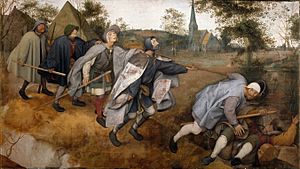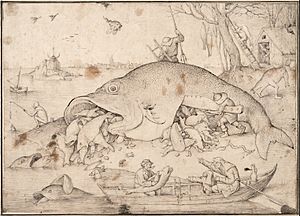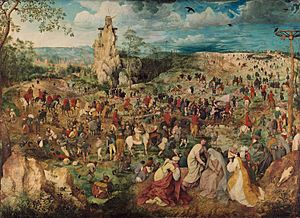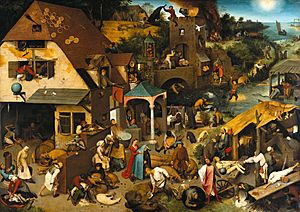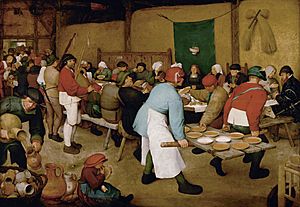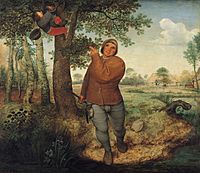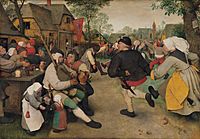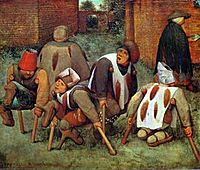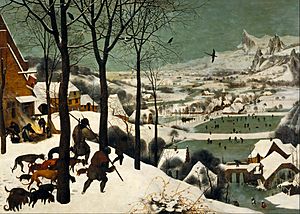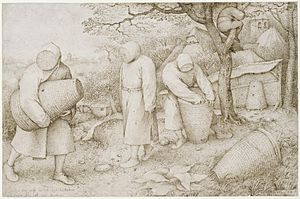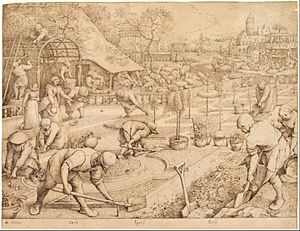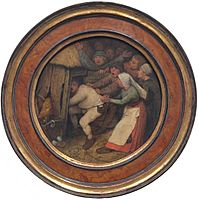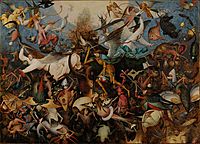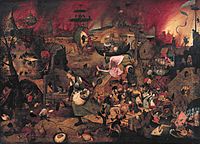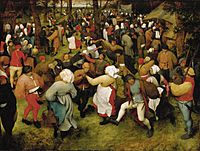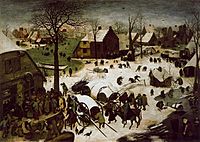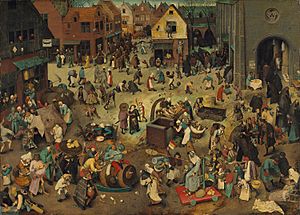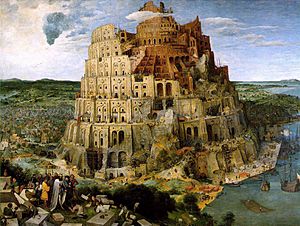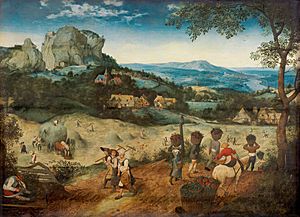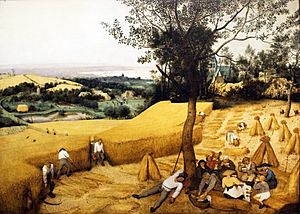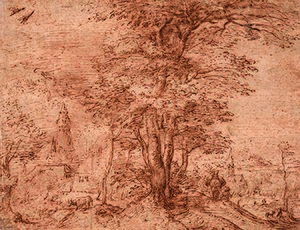Pieter Bruegel the Elder facts for kids
Quick facts for kids
Pieter Bruegel the Elder
|
|
|---|---|
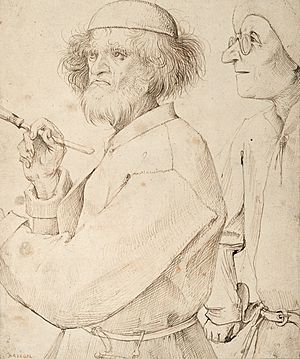
The Painter and The Connoisseur, c. 1565, possibly Bruegel's self-portrait
|
|
| Born |
Pieter Bruegel
c. 1525–1530 Breda or Breugel (modern-day Netherlands)
|
| Died | 9 September 1569 (aged 39 to 44) |
| Known for | Painting, printmaking |
|
Notable work
|
The Hunters in the Snow, The Peasant Wedding, The Tower of Babel |
| Movement | Dutch and Flemish Renaissance |
Pieter Bruegel (also spelled Brueghel or Breughel) the Elder was a very important artist from the Dutch and Flemish Renaissance. He was a painter and a printmaker. He is famous for his amazing landscapes and scenes of everyday peasant life, which are called genre paintings. He was one of the first artists to make these types of scenes the main focus of his large paintings.
Bruegel greatly influenced Dutch Golden Age painting and art in general. He was one of the first artists who grew up when religious topics were no longer the only subjects for paintings. He also did not paint any portraits, which was unusual for artists back then. After his training and travels to Italy, he settled in Antwerp in 1555. There, he mostly designed prints for a major publisher.
Later, he started focusing on painting. All his most famous paintings come from the last ten years of his life. He died young, probably in his early forties, when he was at the peak of his artistic powers.
Bruegel's art brought new life to older subjects. He took everyday scenes from medieval illuminated manuscripts and calendar pictures of farm work. He made these much larger and painted them using expensive oil paints. He also explored the wild and imaginative world found in Renaissance prints and book pictures.
People sometimes call him "Peasant Bruegel." This helps tell him apart from other painters in his family, like his son Pieter Brueghel the Younger. From 1559, he stopped using the 'h' in his name and signed his paintings as Bruegel. His family members, however, kept using "Brueghel" or "Breughel."
About Bruegel's Life
His Early Years
We learn about Bruegel's life from two main old sources. One is a book from 1567 by Lodovico Guicciardini. The other is Karel van Mander's Schilder-boeck from 1604. Guicciardini said Bruegel was born in Breda. Van Mander said he was born in a village near Breda called "Brueghel." We don't know anything about his family.
For a long time, people thought Bruegel came from a peasant family. This was because he painted so many peasant scenes. But in recent years, experts have looked closely at his work. They now believe he was a well-educated city person. He was friends with smart thinkers of his time. Breda was a big city back then.
Bruegel joined the painters' guild in Antwerp in 1551. This suggests he was born between 1525 and 1530. His teacher was an Antwerp painter named Pieter Coecke van Aelst. Bruegel worked for Pieter Coecke between 1545 and 1550. Before that, he also worked in Mechelen. He helped another artist paint an altarpiece there.
His Travels
In 1551, Bruegel became a master in the Guild of Saint Luke in Antwerp. Soon after, he traveled to Italy, probably through France. He visited Rome. By 1552, he reached Reggio Calabria at the very south of Italy. A drawing he made shows the city on fire after an attack. He might have gone to Sicily too. By 1553, he was back in Rome.
In Rome, he met a miniature painter named Giulio Clovio. Clovio's will from 1578 mentions paintings by Bruegel. Some were even joint works. These paintings, which were likely landscapes, are now lost. But some small drawings in Clovio's books are thought to be by Bruegel.
Bruegel left Italy by 1554. By 1555, he was back in Antwerp. That year, a famous series of prints called the Large Landscapes was published. Bruegel designed these prints. Unlike most artists visiting Rome, Bruegel seemed to ignore old Roman ruins and new buildings. He focused on drawing landscapes.
Life in Antwerp and Brussels
From 1555 to 1563, Bruegel lived in Antwerp. This city was a major center for publishing in northern Europe. He mostly designed over forty prints for Hieronymus Cock, a big publisher. His first dated paintings appeared in 1557. Bruegel usually made the drawings, and then Cock's experts would create the prints. He was part of the lively group of smart thinkers in the city. In 1559, he changed the spelling of his name from "Brueghel" to "Bruegel." This was like making it sound more Latin. He also changed his signature style.
In 1563, Bruegel married Mayken Coecke. She was the daughter of his old teacher, Pieter Coecke van Aelst. They moved to Brussels, where he lived for the rest of his short life. Antwerp was a business and art center. Brussels, however, was where the government was. Painting became his main work, and his most famous pieces come from these years.
His paintings were very popular. Rich collectors and important government officials bought them. Bruegel had two sons, both of whom became famous painters. They were Pieter Brueghel the Younger (born 1564) and Jan Brueghel the Elder (born 1568). He died too early to teach them himself. Bruegel passed away in Brussels on September 9, 1569. He was buried in the Kapellekerk.
Before he died, Bruegel told his wife to burn some of his drawings. These might have been designs for prints. He worried they were "too sharp or sarcastic." He might have felt bad about them or feared they could cause trouble for his wife. This has made people wonder if they were about politics or religion, which were sensitive topics back then.
The World Bruegel Lived In
Bruegel lived during a time of big changes in Europe. New ideas from the humanist movement were influencing artists and thinkers. Italy was finishing its High Renaissance, with artists like Michelangelo and Leonardo da Vinci creating masterpieces. In 1517, before Bruegel was born, Martin Luther started the Protestant Reformation in Germany.
The Reformation led to iconoclasm, which was the widespread destruction of art. This happened in the Low Countries too. The Catholic Church saw Protestantism as a threat. The Council of Trent, which ended in 1563, decided that religious art should focus more on religious themes. It should be less about fancy decorations.
At this time, the Low Countries were divided into Seventeen Provinces. Some of these wanted to be free from Spanish rule. The Reformation also brought new Protestant religions. These gained followers in the Seventeen Provinces. The Spanish rulers tried to make everyone follow the Catholic Church. They used the Inquisition to enforce this. Growing religious fights, political struggles, and executions eventually led to the Eighty Years' War.
Bruegel's career was at its peak during this tense time. Two years before he died, the Eighty Years' War began. This was a war between the United Provinces and Spain. Bruegel did not live to see the end of the war. But seven provinces became independent and formed the Dutch Republic. The other ten stayed under Spanish control.
Bruegel's Art Subjects
Peasant Life

Pieter Bruegel was known for his genre paintings. These paintings showed scenes of everyday life, often with peasants. They usually included a landscape. It was rare for painters in Bruegel's time to focus on the lives of peasants. He was a pioneer in this type of art. Many of his peasant paintings have two main styles. Both were new and influenced later art.
His earlier style shows many small figures. They are seen from a high view and spread out across the painting. The setting is often a town with buildings. The people in these paintings are doing their own things. They don't seem to notice each other.
Bruegel showed village life in a real, down-to-earth way. He painted farming, hunts, meals, festivals, dances, and games. These paintings give us a unique look at how people lived in the 1500s. They show us what their culture was like. For example, his famous painting Netherlandish Proverbs shows dozens of old sayings. Many of these sayings are still used today. Children's Games shows all the different ways young people played.
His winter landscapes from 1565, like The Hunters in the Snow, show how cold the winters were during the Little Ice Age. Bruegel often painted community events. Examples are The Peasant Wedding and The Fight Between Carnival and Lent. In The Peasant Wedding, he painted real, individual people. But in The Fight Between Carnival and Lent, the people are more like symbols.
Bruegel also painted religious scenes. He often placed them in wide Flemish landscapes. Examples include Conversion of Paul and The Sermon of St. John the Baptist. Even if his subjects were unusual, the religious ideas and proverbs in his paintings were typical of the Northern Renaissance. He accurately showed people with disabilities. For example, in The Blind Leading the Blind, he painted a Bible quote. It says, "If the blind lead the blind, both shall fall into the ditch." This painting can mean that people are blind when they chase earthly goals instead of following Christ's teachings.
With great energy and humor, Bruegel created some of the first art that showed social protest. Examples are The Fight Between Carnival and Lent, which made fun of the conflicts during the Protestant Reformation. His prints like The Ass in the School also showed this.
As the 1560s went on, Bruegel changed his style. He started painting fewer figures, but they were much larger. They were usually in a landscape background without a far-off view. His paintings that focused on landscapes had a mix of figures.
Landscape Paintings
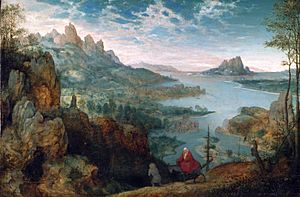
Bruegel made the "world landscape" style more natural. This style shows small figures in a wide, imaginary landscape. It is seen from a high viewpoint and includes mountains, lowlands, water, and buildings. After returning to Antwerp from Italy, he was asked by the publisher Hieronymus Cock to draw for a series of engravings. These were called the Large Landscapes. There was a growing demand for landscape pictures at that time.
Some of his earlier paintings, like Landscape with the Flight into Egypt (1563), follow the older style. But his Landscape with the Fall of Icarus (known from two copies) had a landscape in this style. In this painting, the largest figure is just an everyday person. They are a bystander to the main story and might not even know it's happening. The date of Bruegel's original painting is not clear. But if it's early, it shows what his later works would be like. In the 1560s, he moved from crowded scenes with many tiny figures to paintings with a few much larger figures.
Paintings of the Months
Bruegel's famous series of landscapes showing the seasons are the best examples of his landscape style. Five of these paintings still exist. They use parts of the "world landscape" style. But he changed them into his own unique style. These paintings are larger than most earlier works. They have a genre scene with several figures in the front. The wide view is seen past or through trees. Bruegel also knew about the landscape style of the Danube School through prints.
The series about the months of the year includes some of Bruegel's most famous works. In 1565, a rich person in Antwerp, Niclaes Jonghelinck, asked him to paint a series for each month. Art experts disagree if there were originally six or twelve paintings. Today, only five of these paintings remain. Some months are grouped to show a general season. Old Flemish books of hours had calendar pages. These showed "Labours of the Months." They were pictures of farm tasks, weather, and social life typical for each month.
Bruegel's paintings were much larger than typical calendar page pictures. Each one was about three feet by five feet. This was a big and important job for Bruegel. In 1565, the Calvinist riots began. The Eighty Years' War started just two years later. Bruegel might have felt safer with a non-religious job. This way, he would not upset Calvinists or Catholics. Some of the most famous paintings from this series are The Hunters in the Snow (December–January) and The Harvesters (August).
Prints and Drawings
When Bruegel returned to Antwerp from Italy, he made a living by creating drawings for prints. These prints were made by Hieronymus Cock, a leading publisher in northern Europe. Cock's company was very good at making and selling many kinds of prints. Most of Bruegel's prints come from this time. But he kept making drawings for prints until he died. He left only two drawings finished from a series about the Four Seasons. The prints were popular, and it seems all of them have survived. We also have many of Bruegel's original drawings.
The subjects of his prints were often similar to his paintings. But there were also big differences. For a long time, people knew Bruegel more from his prints than his paintings. This is because public museums and good copies of paintings were not common yet. This led people to think of him mostly as an artist who made funny peasant scenes.
Most of the prints are engravings. After 1559, some were etchings or a mix of both. Only one complete woodcut was made from Bruegel's design. Another was left unfinished. This unfinished one, The Dirty Wife, is very rare. It's a drawing on a wooden block meant for printing. For some reason, the person who carved the block only did one corner before stopping. The design later appeared as an engraving.
Some of his biggest successes were a series of allegories. These were designs that used the unique style of his countryman Hieronymus Bosch. They included The Seven Deadly Sins and The Virtues. The sinners look strange and hard to identify. The figures showing virtues often wear odd hats. People liked copies of Bosch's work. This is shown by Bruegel's drawing Big Fish Eat Little Fish. Bruegel signed it, but Cock falsely said Bosch made it on the print version.
We don't have any drawings that were clearly made as studies for his paintings. Most of the drawings that still exist are finished designs for prints or detailed landscape drawings. After many drawings were checked by experts, sixty-one drawings are now believed to be by Bruegel. Another group of about twenty-five landscape drawings, many signed by Bruegel, are now thought to be by Jacob Savery. These seem to have been made as fakes.
Bruegel's Family
Around 1563, Bruegel moved from Antwerp to Brussels. There, he married Mayken Coecke. She was the daughter of the painter Pieter Coecke van Aelst and Mayken Verhulst. Their marriage was recorded on July 25, 1563, and they married in the Chapel Church in Brussels.
Pieter the Elder had two sons: Pieter Brueghel the Younger and Jan Brueghel the Elder. Both of them kept the "Brueghel" spelling in their names. Their grandmother, Mayken Verhulst, taught the sons to paint. This was because their father died when they were very young children. The older brother, Pieter Brueghel the Younger, copied his father's style and paintings very well. He had great success selling them. Jan was much more original and could paint many different things. He was important in the change to the Baroque style in Flemish Baroque painting and Dutch Golden Age painting. He often worked with other leading artists, like Peter Paul Rubens.
Other artists in the family include Jan van Kessel the Elder (Jan Brueghel the Elder's grandson) and Jan van Kessel the Younger. Through David Teniers the Younger, who married Jan Brueghel the Elder's daughter, the family is also connected to the Teniers family of painters and the Quellinus family of painters and sculptors.
|
||||||||||||||||||||||||||||||||||||||||||||||||||||||||||||||||||||||||||||||||||||||||||||||||||||||||||||||||||||||||||||||||||||||||||||||||||||||||||||||||||||||||||||||||||||||||||||||||||||||||||||||||||||||||||||||||||||||||||||||||||||||||||||||||||||||||||||||||||||||||||||||||||||||||||||||||||||||
Bruegel's Works
There are about forty of Bruegel's paintings that are still around and generally accepted as his. Twelve of these are in the Kunsthistorisches Museum in Vienna. We know that several other paintings have been lost. One of them, which Bruegel himself thought was his best, was called "a picture in which Truth triumphs."
Bruegel only etched one plate himself, called The Rabbit Hunt. But he designed about forty prints, including both engravings and etchings. Most of these were for the Cock publishing house. As mentioned before, about sixty-one drawings are now considered real. Most of these are designs for prints or landscapes.
-
The Census at Bethlehem (1566)
Some Famous Works by Bruegel
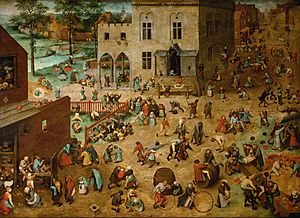
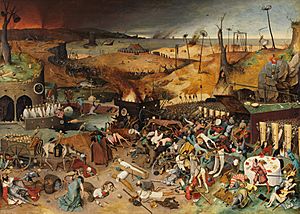
- Parable of the Sower, 1557
- The Blue Cloak (or Flemish Proverbs), 1559
- The Fight Between Carnival and Lent, 1559
- Children's Games, 1560
- The Fall of the Rebel Angels, 1562
- Two Monkeys, 1562
- The Triumph of Death, c. 1562
- Dulle Griet (Mad Meg), c. 1563
- The "Large" Tower of Babel, 1563
- The "Little" Tower of Babel, c. 1563
- Landscape with the Flight into Egypt, 1563
- The Procession to Calvary, 1564
- The Adoration of the Kings, 1564
- The Months, a series of paintings, five of which remain:
- The Hunters in the Snow (Dec.–Jan.), 1565
- The Gloomy Day (Feb.–Mar.), 1565
- The Hay Harvest (June–July), 1565
- The Harvesters (Aug.-Sept.), 1565
- The Return of the Herd (Oct.–Nov.), 1565
- Preaching of John the Baptist, 1566
- The Census at Bethlehem, 1566
- The Wedding Dance, c. 1566
- Conversion of Paul, 1567
- Massacre of the Innocents, c. 1567
- The Land of Cockaigne, 1567
- The Adoration of the Magi in the Snow, 1567
- The Magpie on the Gallows, 1568
- The Misanthrope, 1568
- The Blind Leading the Blind, 1568
- The Peasant Wedding, 1568
- The Peasant Dance, 1568
- The Beggars (The Cripples), 1568
- The Peasant and the Nest Robber, 1568
- The Storm at Sea, an unfinished work, probably Bruegel's last painting.
- The Wine of Saint Martin's Day, (discovered in 2010)
- Prints and drawings
- Large Fish Eat Small Fish, 1556
- Ass at School, 1556, drawing
- The Calumny of Apelles, 1565, drawing
- The Painter and the Connoisseur, drawing, c. 1565
- Village views with trees and a mule, 1526–1569
See also
 In Spanish: Pieter Brueghel el Viejo para niños
In Spanish: Pieter Brueghel el Viejo para niños
- List of paintings by Pieter Bruegel the Elder
- Early Netherlandish painting
- Dutch and Flemish Renaissance painting


